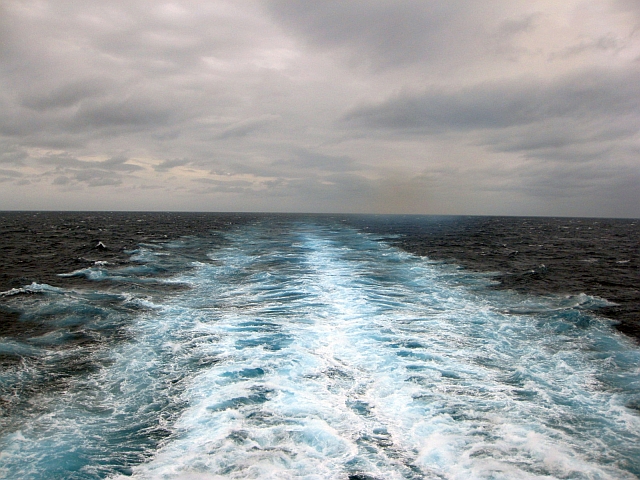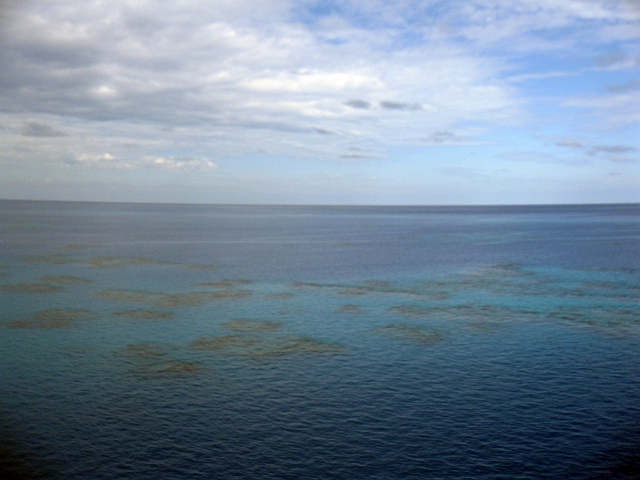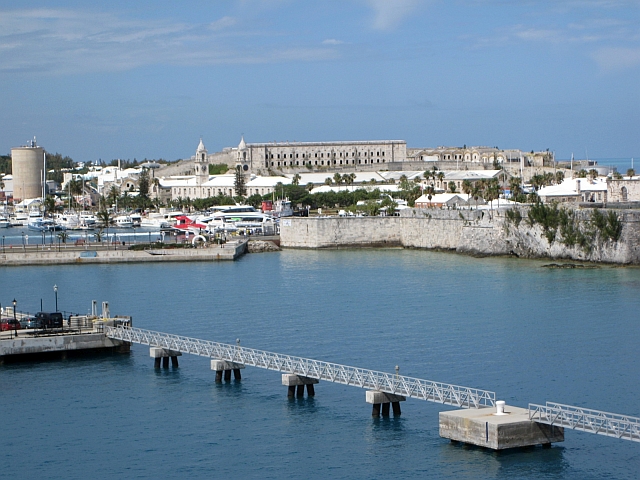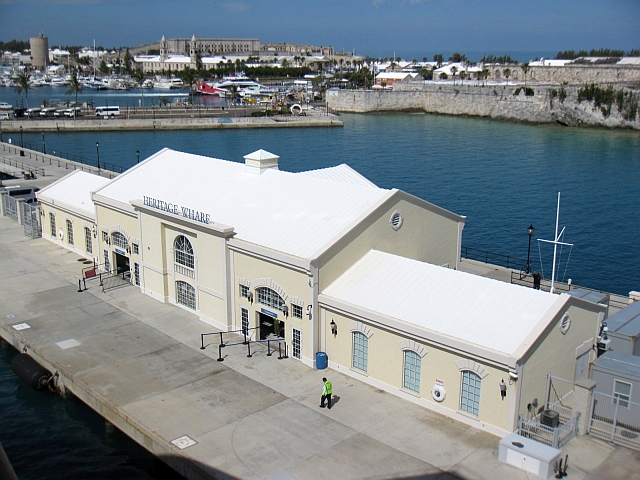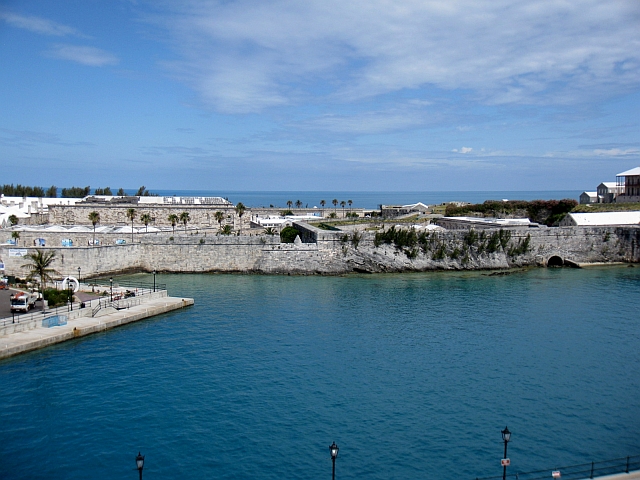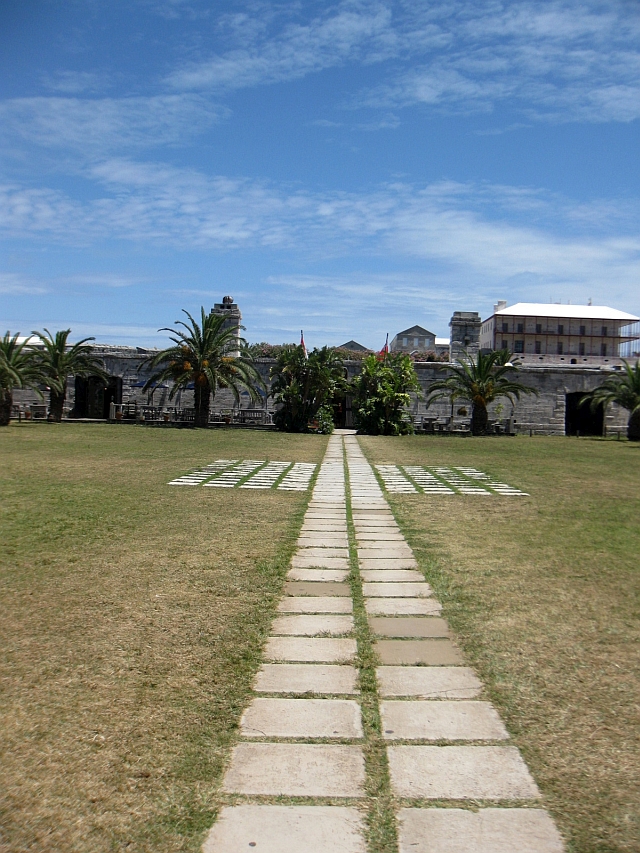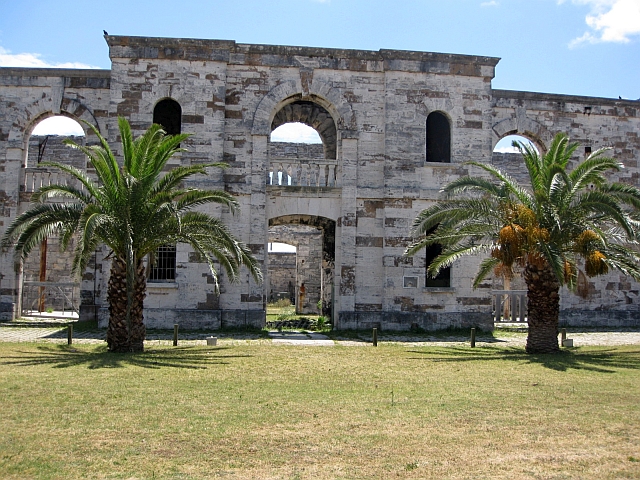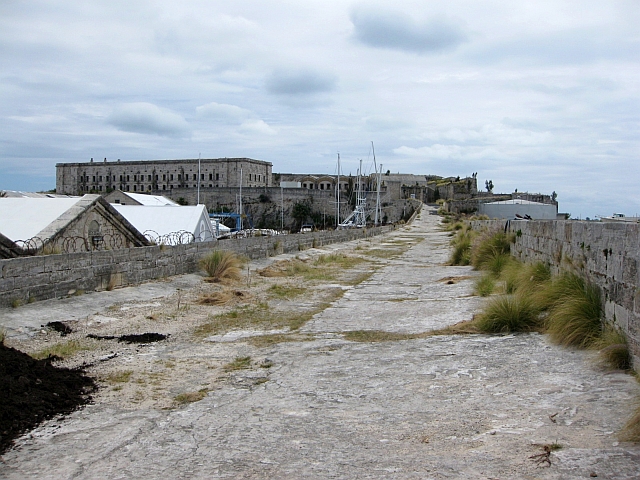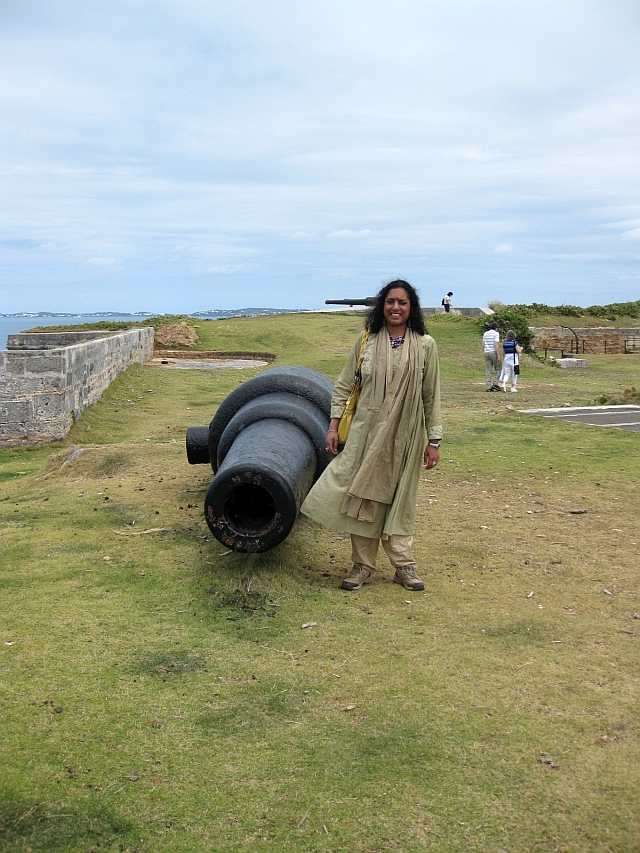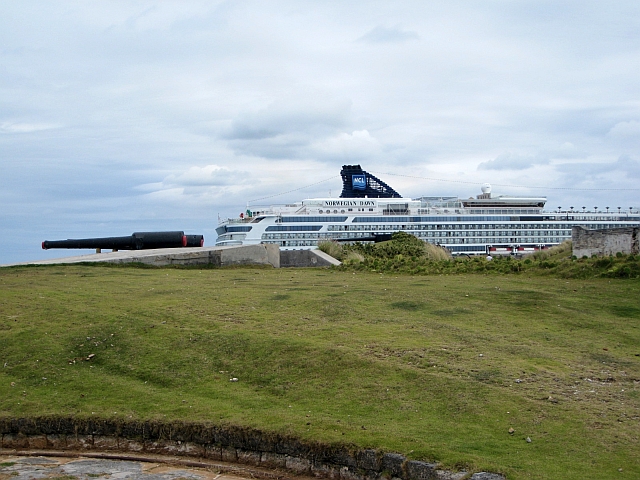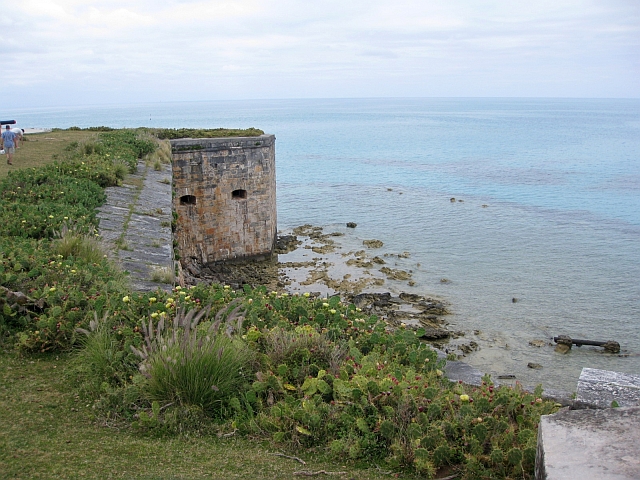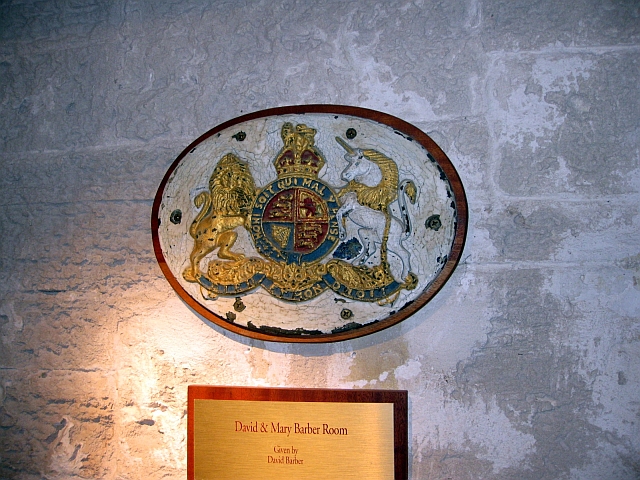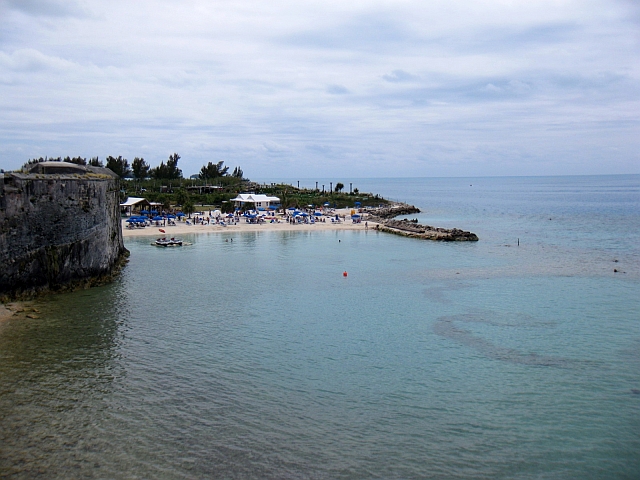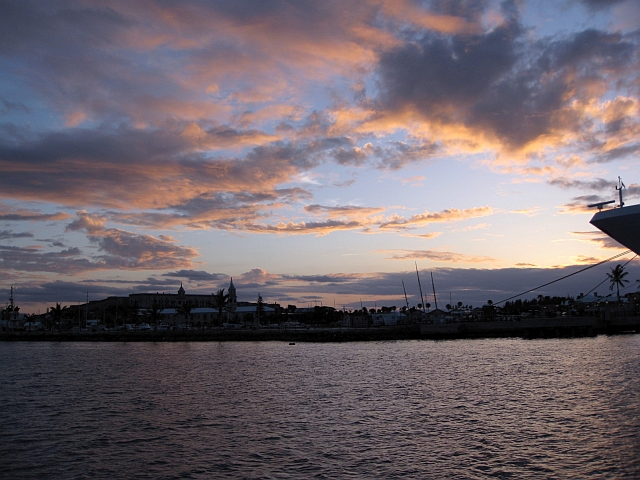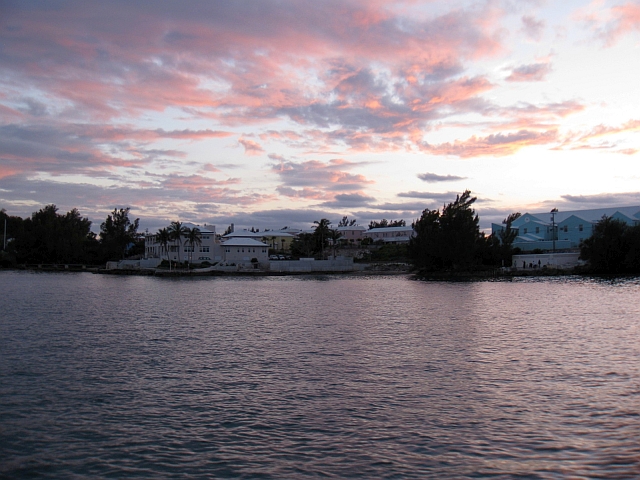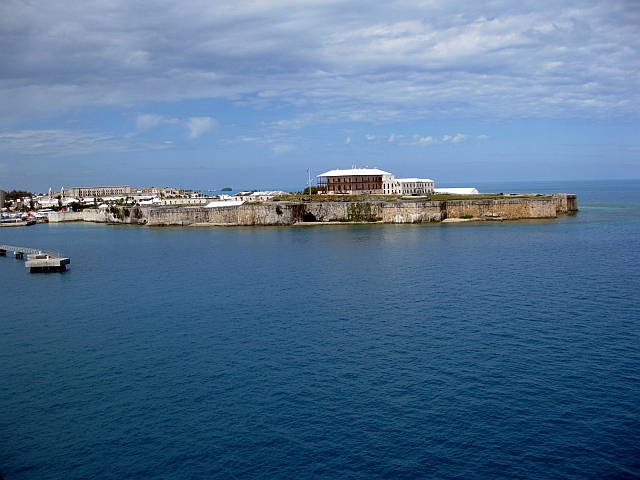
Approaching Royal Naval Dockyard from our cruise ship
This is Part 4 of my road trip-cum-cruise vacation to Bermuda via Boston. In Part 3, we left off as our ship, the Norwegian Dawn, sailed off into the sunset (literally) on Friday, May 16th from Cruiseport Boston on our 7-night crusie to the beautiful islands of Bermuda. Here, we fast forward to Sunday, May 18th, as our ship approaches the islands after a day and a half cruising the open waters of the North Atlantic.
For the introductory post and full trip report index, click here.
Bermuda is incredibly isolated from the rest of the world – the closest populated area is Cape Hatteras, North Carolina, at a distance of some 600 miles – so it takes a bit of time to actually get there from Boston. We sailed out of port shortly after 4 P.M. on Friday, and docked at the Royal Naval Dockyard a little before 11 A.M. on Sunday, for a travel time of approximately 43 hours.
On our way down, the weather wasn’t horrible, though it wasn’t exactly spectacular, either, with overcast skies and pretty strong winds. We’re not pool people, so it didn’t really bother us, but I’m sure those who were hoping to get some sun out on the pool deck weren’t happy. The overcast skies also led to a medicore day of picture taking, though I did get a good photo of the ship’s dramatic wake.
The weather cleared on Sunday morning, just in time for our approach to Bermuda. I’d mentioned that one of my favorite activities on board a cruise ship is sitting out on the balcony to watch the sailaway from port. I should have clarified that watching the ship sail into port is equally fascinating. I usually like to move around from our stateroom to various parts of the ship to enjoy the land approach from different points of view.
First sight of Bermuda’s famous coral reefs
The Clocktower Mall and old military barracks
Heritage Wharf, one of two cruise ship docks
The old fortress
The Royal Naval Dockyard is located at the far western end of Bermuda, approximately 24 km (18 miles) from Hamilton in Sandys Parish. The Dockyard and associated fort and pier (King’s Wharf) were originally built in 1809, as in the aftermath of the Revolutionary War, the British needed an alternative defense outpost in the Atlantic. The Dockyard was an important British military outpost in the War of 1812, and for about 100 years afterwards. However, the Dockyard began to wane in importance after World War I, and many of the facilities were abandoned in the early 1950s, with only some skeletal operations remaining until 1995. The area fell into disrepair, but began to enjoy a comeback a few years later as the new era of larger, modern cruise ships began to dock at King’s Wharf when visiting Bermuda. (Cruise ships used to dock in Hamilton or St. George’s, but today’s mass market ships are too large for the harbors in either place.) Now, thanks to extensive ship traffic, a second pier has been built (Heritage Wharf, where we docked), and the area is chock full of attractions with the Clocktower Mall, other shops, pubs and restaurants, museums, and tourist attractions within walking distance of the cruise ship piers.
Before I get in to my review of our day, I first feel obligated to make one public service announcement. Once you arrive in Bermuda, or even while researching things to do in the country from home, you will be bombarded with ads for moped rentals as a way to self-tour the country. Piece of advice: don’t do it. Disregard of traffic rules isn’t really the issue, but the narrow, curvy roads and sometimes uneven surfaces are. Combined with the fact that you must share the roads with city buses and transport trucks that barely fit on the roads, riding a moped can be dangerous. Cruise ship forums like Cruise Critic tend to be full of stories of people that decided to rent a scooter, and ended up in the ship’s infirmary with a nasty case of road rash thanks to a fall (and sure enough, we saw a poor tourist on the side of the road bruised and battered by a fall at a curve in the road). That’s bad enough, but you’re also going to be facing a pricey bill for damages from the rental agency when your scooter skids along the pavement after your fall. If you don’t believe in guided tours, get a taxi or minibus to get around. Or if you’re really cheap like me, ride the bus or ferry (more on transport options at the end of this post).
Anyway, our plan for the day was simple: we’re in Bermuda, so we want to wander around and get lost. Well, not really the get lost part, but we did want to wander around. We debated between hanging around the Dockyard or heading to Hamilton on the ferry on our first day, but after hearing that much of Hamilton is shut down on Sundays, decided to stay at the Dockyard. It was nearing lunchtime, though, so our first stop would be the excellent Frog & Onion Pub, just a short 5-minute walk from the ship. The pub is in the “Victualling Yard” portion of the Dockyard, a section that is still being restored.
After lunch, we took a quick look around the Bermuda Arts Center and Bermuda Craft Market next door. As the names imply, the Arts Center features paintings, sculptures, and other pieces of art by local Bermudian artists, while the Craft Market carries various locally produced trinkets, including sea glass jewelry (more about sea glass in my next trip report installment). You can buy rum cakes there as well, but there is a better selection at the Carole Holding store at the Clocktower Mall, which we visited later (I won’t spend any time talking about the mall – it’s a typical tourist trappy shopping mall in a pretty old building). Get a rum cake if you come to Bermuda, but be aware that they aren’t cheap, at a whopping $7.50 apiece for a very small cake.
Across the street is the Bermuda Maritime Museum, where we spent a good amount of time exploring. The museum actually consists of four distinct parts – the old fort grounds, old military barracks later converted to a maximum security prison, a museum chronicling the military history of Bermuda from the 17th century, and the “Dolphin Quest”, a touristy exhibit where you can go into a pool and play with some captive dolphins. Admission for the entire complex is $12/person. We skipped the Dolphin Quest – I can’t swim, and don’t really like the whole captive dolphin thing anyway – but did visit everything else. If you’re a history and/or museum buff, there are a lot of very cool things to see here, from old military weapons, to the old prison buildings, to some very interesting exhibits about Bermuda’s history, both military and with respect to its role in the “Middle Passage” of slaves from Africa to North America. You also enjoy excellent views of the surrounding coastline. We spent about 2 hours here, but you can easily spend twice that.
Old barracks and prison (you can walk all the way across, but cannot enter the buildings)
Replica of cannons that used to be housed here
Our ship transformed into a frigate thanks to a cannon strapped to the aft
Cactii in bloom, overlooking the coral reef
The coat of arms of Bermuda
Once finished here, we walked over to the Clocktower Mall to get some rum cakes, then walked around the area for about half an hour just to burn off some more lunch. There really isn’t anything of note beyond the Clocktower Mall to see. There aren’t any real beaches in Dockyard, though if you need a beach fix and don’t feel like going more than shouting distance from the ship, there is a man-made beach known as Snorkel Park next door to the Bermuda Maritime Museum.
As the name implies, you can snorkel on the reef at this place, if that strikes your fancy. Admission is $5 Monday-Saturday through 10 P.M., and $10 after 10 P.M. and on Sundays. Kids admission is free. Beach chair/jet ski/snorkel equipment rentals are also available at additional charge, and there is a restaurant and bar on-site. The dance party is definitely on after 10 P.M.; we could hear it from our stateroom with the balcony door open. If the fake beach doesn’t do it for you, there is a real one on Ireland Island South, about a mile or so from the cruise ship pier, but getting there requires walking over a bridge with no shoulders or sidewalks.
After a quick return to our stateroom to put away our rum cakes and rest a little, it was time for the featured event of the day – we planned to intentionally ride a boat out to the Bermuda Triangle at night to get lost in the abyss. Well, OK, not exactly. We took an NCL-organized excursion on a glass-bottomed catamaran to sail around the west end of Bermuda for an hour and a half or so around sunset, then continue out to the reef to view reef wildlife and a shipwreck after dark (we really did venture into the Bermuda Triangle, which begins just off the west end of the country). We didn’t get lost, but did endure an hour’s worth of corny getting lost in the Bermuda Triangle jokes. The scattered clouds did make for a colorful sunset, and we did enjoy seeing the reef and shipwreck beneath the glass bottom (sorry, couldn’t get good enough quality photos to post).
Next time – enjoy an exciting day of hunting for sea glass, visiting more forts, and much more in historic St. George’s, on the east end of Bermuda.
If you like looking at photos, you can view many more on Flickr here.
Miscellaneous Information about Bermuda
– Currency – technically the Bermuda dollar, but because it is pegged to par with the US dollar, you can use US dollars anywhere – no need to exchange money. Foreign transaction fees still apply with the use of credit cards, though, so make sure your card doesn’t charge fees before using it.
– Climate – Bermuda is at approximately the same latitude as Myrtle Beach, South Carolina, so air and sea temperatures aren’t nearly as warm as islands in the Caribbean. Maximum temperatures range from the upper 60s in winter to the mid 80s in summer, though high levels of humidity make it feel quite a bit warmer in the summer. There is no specific rainy season, though Bermuda is subject to hurricane season from June through November.
– Language – being a part of the British Commonwealth, everybody speaks English.
– Transportation – Bermuda is a collection of small islands spread over a small area of the open North Atlantic. The islands have a good public transportation system, with buses and ferries providing service to most of Bermuda’s important places and beaches. Fares range from $3-4.50 one way (exact change only), depending on distance, or you can buy multi-day passes ($15 one day/$25 two day/$35 three day) that provide unlimited rides during the period of validity. Before buying a transit pass, carefully consider how much you’ll actually use the buses and ferries before buying. For example, if you buy a 2-day pass, you’ll need to take at least 6 one-way rides in order to get your money back. Click here for more information on bus and ferry routes and fares. If you’re coming in on a cruise ship, there are four places to buy passes: 1) inside the Heritage Wharf and King’s Wharf customs buildings; 2) at the small shack looking building at the end of the pier; 3) at the ferry terminal; and 4) on the cruise ship itself. Same prices everywhere, but you can charge the cost to your onboard account if you buy your tickets onboard the ship, whereas it’s cash only everywhere else. The shortest lines were generally at the shack-looking building at the end of the pier.
The Dockyard area itself is very compact – less than a mile from one end to another – so there’s really no need for doing anything other than walking. And as I mentioned earlier, if you’re considering renting a moped – don’t.
– Food – above all else, you’ll notice the British influence in Bermudian cuisine. Much as fish and chips, Shepherd’s Pie, and chicken curry can be found in pretty much any restaurant in the UK, you’ll find them everywhere in Bermuda, too. There is also a distinct Caribbean influence in the country’s foods, though, adding a touch of kick to what you would otherwise consider rather bland cuisine.
Of course, seafood is king here, especially lobster in season. Fish chowder is also a local specialty. If you’re a beer drinker, don’t forget that many restaurants also feature their own microbrews on tap. The Frog & Onion, for example, carries their own brand of local brew, made on the premises.
– Other – Bermuda has a reputation for being an expensive place to visit. I didn’t really find that to be the case. It certainly wasn’t cheap, but prices for things like restaurant meals weren’t overly outrageous, generally $30-35 per person, tip included. Likewise, there are plenty of junky trinkets to be had in the $10-20 range.

